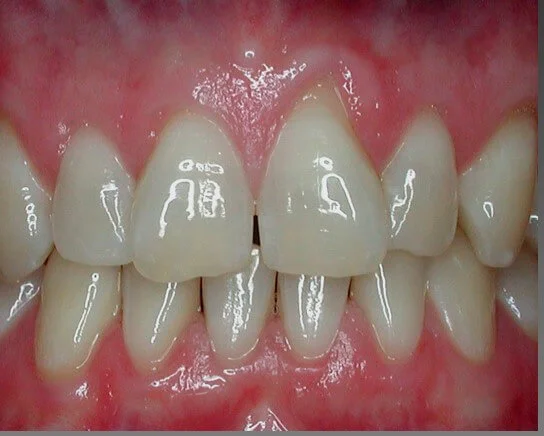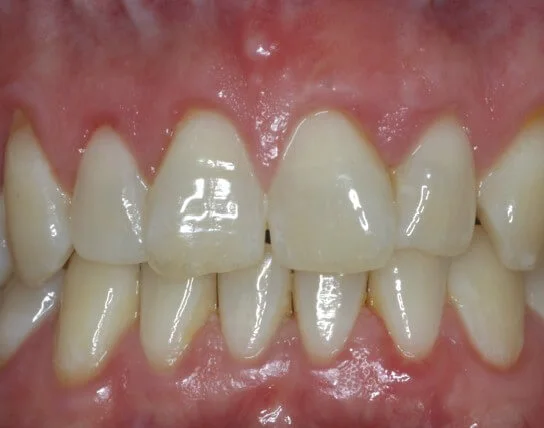

Gum Grafting For Exposed Roots
What Is Gum Recession?
Gum recession is when the connection of the gum to the tooth moves away from its original position, exposing the tooth root. The root can be sensitive. If gum recession is seen when you smile, then recession can be an esthetic problem. Gum tissue, or gingiva, is thick, dense tissue that protects the bone. Sometimes, there is gum recession, and no gingiva is present. When this occurs, the bone is covered with only mucosa, which does not protect the supporting bone of the tooth very well. Mucosa is the tissue that lines your cheeks. It is thin and flexible and not thick and dense like gingiva.
How Is Gum Recession Treated With My Tissue?
Gum Recession treated with your tissue involves moving tissue from the top of the mouth and placing it where more gum is needed. Tissue is transferred from the top of the mouth (palatal area) along the side or from behind the last tooth on the top of the mouth, where it is out of the way and unnoticed. The graft is placed under the tissue where the graft is needed and held in place with small sutures or stitches. The removal of most sutures occurs after two weeks of healing. Dr. Wiland rechecks the area after two months. The donor site is the top of the mouth where gum tissue is taken and moved to where it is needed. The donor site will have a slight indentation where the gum was removed. The indentation fills in and returns to normal in about two to three months but is not uncomfortable. Gum grafting can frequently cover exposed roots. The recovery is quick, with minimal discomfort. Autogenous gum grafting is the only technique that will continue to look and feel better as time progresses.


Does All Gum Recession Need Treatment?
Gum recession is treated if gingiva is not present to protect the bone or if the gum recession is severe or worsening. Recession should also be treated before orthodontic (braces) treatment if there is little or no gum tissue. If you do not like the appearance of your teeth and gums because of gum recession, then treatment may be able to correct this.
What Are the Treatment Options for Gum Recession?
There are generally three different treatment choices for gum recession.
Autogenous Gum Grafting
This technique uses your tissue to increase the thickness and gum tissue and protects the bone. This technique has been in use longer than other procedures.
Acellular Dermal Matrix (ADM) Grafting
This technique uses donor tissue purchased from a company and not your own tissue. The advantage of this technique is that there is only one surgical site since there is no need to involve the top of the mouth. More information can be on the section for ADM.
Chao Pinhole Surgical Technique
This technique involves using collagen strips and special instruments to lift the tissue up and cover the exposed root surfaces. Dr. Wiland became Chao Pinhole Certified in 2016 when Dr. John Chao, the inventor of The Pinhole Surgical Technique, trained him. More information about can be found This technique involves using collagen strips and special instruments to lift the tissue up and cover the exposed root surfaces. Dr. Wiland became Chao Pinhole Certified in 2016 when Dr. John Chao, the inventor of The Pinhole Surgical Technique, trained him. More information about can be found on this website at Chao Pinhole Surgical Technique.
What Causes Gum Recession and How Do I Prevent Gum Recession?
The way the teeth develop and erupt into the mouth can be one cause of gum recession. Some teeth have very little bone, and what bone is present is thin. This bone can resorb with the gum tissue moving with it.
Muscle attachments called frenums can sometimes pull on the gum tissue and contribute to gum recession.
Using a hard or medium-bristled toothbrush with excessive force is another cause of gum recession. Always use a soft-bristled toothbrush. Gently massage the gums to remove the film of bacteria that collects. This film of bacteria is called a biofilm but used to be called dental plaque. It sticks to the tooth and gum area and causes gum disease. It needs to be removed to maintain dental health, but it does not require a lot of force. Most all electric toothbrushes have soft-bristled brush heads. A light touch with a sonic toothbrush allows the brush to work better. Some electric toothbrushes have sensors to indicate if the pressure is too hard. Phillips Sonicare SenseIQ technology will help prevent applying too much pressure. Always use a soft-bristled toothbrush to prevent gum recession.
Trauma to gum tissue is another cause of gum recession. The gum tissue may recede when a traumatic injury has occurred on a tooth or teeth. Floss cutting is one example of trauma to the gum tissue. Do not push the floss into the gum and cut the gum since this can start gum recession. Flossing should involve gently rubbing the tooth to remove the biofilm of bacteria. Gently flossing can prevent one cause of gum recession.
Smoking or the use of smokeless tobacco can irritate the gum tissue and contribute to gum recession.
Will Gum Recession Come Back After Treatment?
Recession should not come back if the cause of the gum recession is corrected. If hard brushing continues, then the recession will come back. But if habits are changed, then the gum recession should not return.
 Schedule an Appointment
Schedule an Appointment
